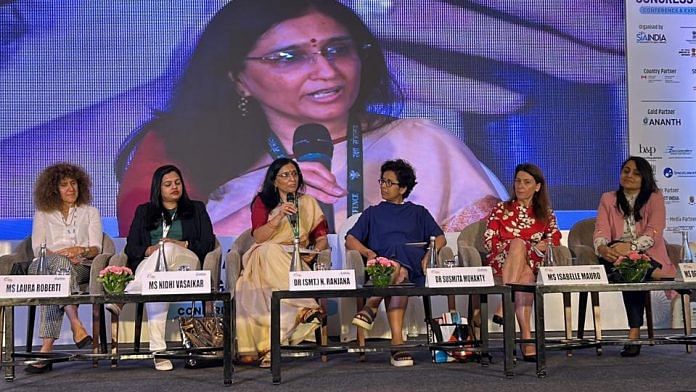New Delhi: In a half-empty conference room, five women spoke about overcoming gender bias in space. But they kept getting interrupted by men in the audience.
The Indian government has opened up the space sector to private companies and startups, but women are still fighting for a seat at the decision-making table — a gap that was clearly visible at the three-day India Space Congress in New Delhi. Male speakers dominated many discussions on Tuesday. And the lone panel chaired by women entrepreneurs and scientists in the space sector—called Breaking Barriers, Inspiring Futures: Women in Space—saw dismal attendance.
Panellist Isabelle Mauro, director general of the Global Satellite Operators Association (GSOA), expressed her frustration at yet again being relegated to a “women’s panel”.
“We need to stop having women’s panels altogether. We need to stop talking among ourselves. We need to be able to talk about business and economics, rather than talking about gender,” she said.
Also read: It can take 131 years to fill the global gender gap. Here’s how we can fastrack it
ISRO must stand up
ISRO came under scrutiny for failing to involve women in key space missions. Dr Susmita Mohanty, who co-founded India’s first private space start-up Earth2Orbit in 2009, wanted to know why women were overlooked in the Gaganyaan programme, India’s ambitious maiden crewed mission to space.
“This is the 21st century. India has the highest number of female pilots in the world, and yet ISRO chose not to include women in the Gaganyaan mission,” said Mohanty, the only space entrepreneur in the world to have started companies on three different continents in Asia, Europe, and North America.
When fellow panellist N Ranjana, the chief of Directorate of Systems and Technology Analysis (DSTA) at DRDO, started adding to Mohanty’s point, a gentleman in the audience interrupted the panel to offer an explanation.
“The first batch of women fighter pilots had only graduated in 2014, whereas recruitments for Gaganyaan started in 2018. At that time, the age and experience requirements for the astronauts was more than what any female fighter pilot had,” he said.
Mohanty stood by her argument, citing the example of Mercury 13 where thirteen female pilots in the US had passed all the rigorous astronaut screening tests in 1959. The programme was run by William Randolph Lovelace II, an American physician who studied aerospace medicine, and was curious to find out if women pilots could clear screening tests designed for male fighter pilots.
All the women passed the tests, although none of them ever flew to space. The only exception was Wally Funk – who flew aboard the Blue New Shepard 4 mission Flight 16 in 2021 – at the age of 82.
Mohanty pointed out that ISRO was repeating the same mistake that NASA made in the 1960s. More initiatives were needed by the space agency and others involved to bridge the gender gap, she said.
Even though women head significant projects at ISRO, the organisation has never had a female director in any of its five centres.
“It took 50 years for the first all-women space walk (by NASA) to happen, and people were celebrating. I think it was something to be embarrassed about – it should not have taken that long,” Mohanty said. “We do not lack women in the tech industry; what we lack are leaders.”
Also read: Indian science communicators are fighting for freedom from jargon. Scientists push back
Missing out
Other panellists blamed this on the deep-rooted patriarchal mindset that often set women back in their STEM entrepreneurship.
Devleena Bhattacharjee, the founder of Maharashtra-based Numer8 Analytics, recalled approaching a bank for a business loan and being asked to provide PAN details of a male family member. She also spoke about a woman’s ‘assigned’ role as a primary caregiver, which often takes precedence over career.
“Empathy and compassion come very naturally to us. That makes us take a step back and take career breaks for the sake of our families,” she said.
Women face societal pressure to get married the moment they start a career. And when they battle those to stay in the job while managing the home, there comes the pressure to have children when they are just settling into their profession, Bhattacharjee explained, adding that maternity leave sets women back by almost a year.
“That role of a caregiver also needs to be shared by men across professions,” she said.
N Ranjana, however, was of the opinion that things were moving much faster today than 30 years ago.
“We often fail to identify the inherent strengths in women. Women are often much more hardworking – especially because they feel they have to prove themselves. We (at DRDO) are always trying to push women, and I am positive that we are going to have women leaders in the space sector very soon,” she said.
(Edited by Prashant)



